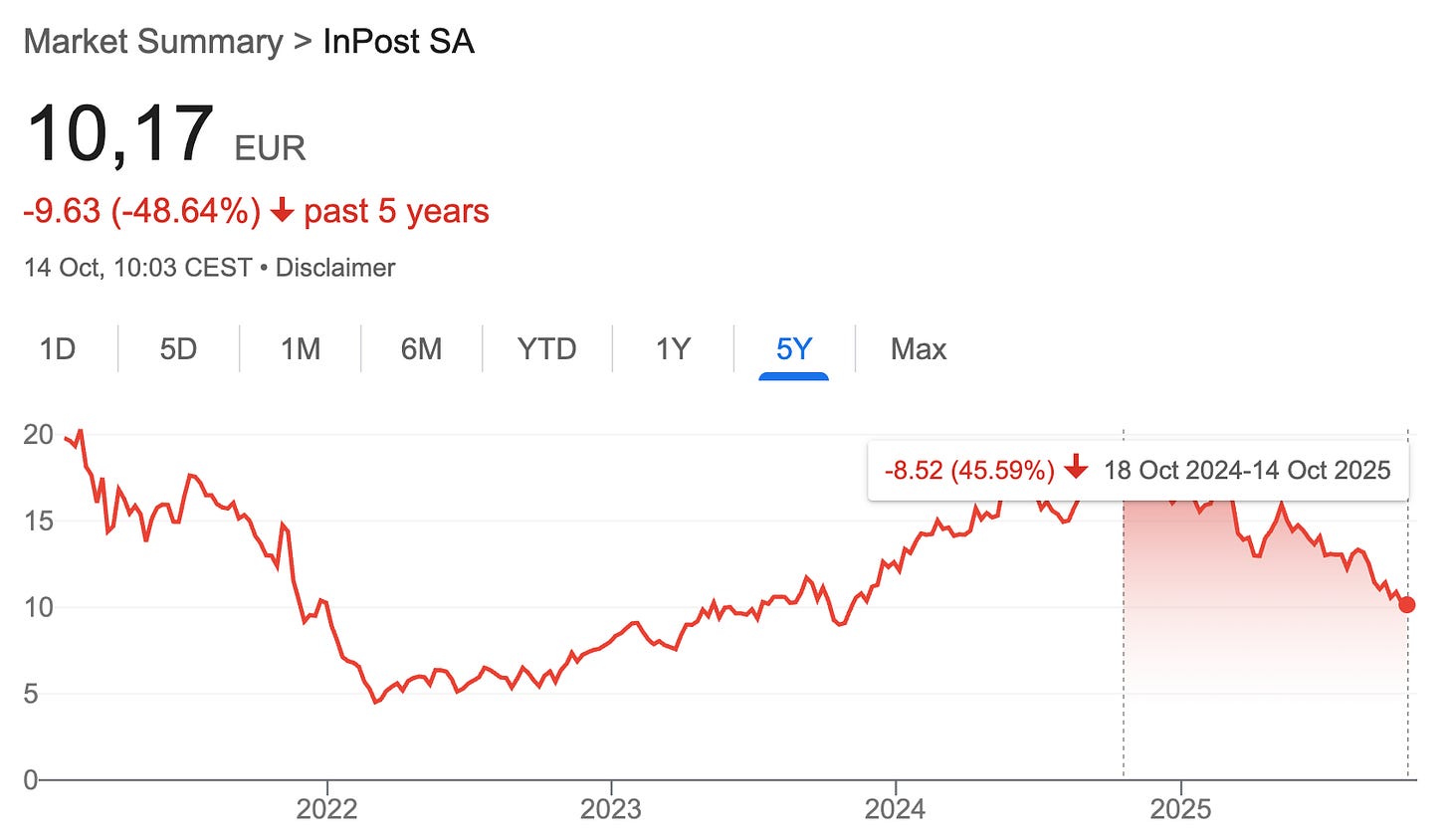InPost at 8x Look-Through Earnings! Building Europe’s E-Commerce Infrastructure, One Locker at a Time (a 30% CAGR Setup)
A deep look at a founder-led logistics platform balancing growth, discipline, and misunderstood potential.
Few European stocks have polarized investors quite like InPost. Since its 2021 IPO on Euronext Amsterdam, the Polish parcel-locker pioneer has seen its share price soar, crash, and then claw its way back as the market tries to decide what, exactly, it’s looking at. Is this a “one-country wonder” that struck gold in Poland and is now overreaching abroad? Or is it a quietly compounding logistics platform whose moat is only beginning to show outside its home market?
The past year has been a reality check. The stock rallied hard in early 2024 on the promise of accelerating international volumes, only to cool again as investors questioned whether profitability in France and the UK would ever resemble the Polish template. At the same time, management has been walking a tightrope: expanding across Europe while trying to prove that the model’s unit economics travel well beyond Warsaw. The company’s H1 2025 results show both progress and friction – revenue still rising double digits, margins stabilizing, but free cash flow weighed down by ongoing investment.
And yet, dig below the noise, and the story looks more intriguing than ever!
More than half of InPost’s business now comes from outside Poland. Locker utilization in the UK and France is hitting inflection points. EBITDA per parcel in mature markets keeps climbing, even as competition intensifies. The business remains misunderstood because it doesn’t fit cleanly into traditional boxes: it’s capital-heavy but scalable, infrastructure-driven but tech-enabled, transactional but habit-forming.
To me, InPost is the most “Peter Lynch-style” stock I’ve researched in quite a while. It’s a rather boring business at first glance – one that many investors might reject too quickly because it lacks an exciting narrative to wrap around it. Yet that’s precisely what makes it interesting. This is a company with a simple, easy-to-grasp model, predictable cash flows, and a structure that’s counter-positioned to incumbents weighed down by legacy courier operations. It’s a fast grower hiding in plain sight, operating in a space most investors would never call glamorous but that quietly compounds volume, habit, and efficiency year after year.
Lynch famously divided stocks into six categories: Slow Growers, Stalwarts, Fast Growers, Cyclicals, Turnarounds, and Asset Plays. InPost clearly sits in the Fast Grower bucket – small enough to be nimble, growing earnings north of 35–40%, and still with a long runway ahead. On a PEG basis, the stock looks strikingly attractive: strong double-digit growth with a multiple that hasn’t yet caught up to its potential. It’s the kind of setup Lynch loved – a “boring” business delivering extraordinary numbers, misunderstood simply because it’s not telling a sexy story.
In this deep dive, I’ll unpack why InPost’s economics are far more powerful than they appear on the surface – and why the stock’s volatility may be masking one of Europe’s most compelling compounders in the making. We’ll explore the core mechanics of the business model, how its competitive advantage really works (and where it might break), the quality of management and capital allocation, the leverage debate, and what the current market skepticism is getting wrong.
For investors willing to look beyond short-term cash-flow optics, InPost offers an interesting proposition: a company spending heavily today to own the infrastructure of how Europe shops tomorrow, and thereby earning very attractive returns on incremental investments that do not show in backward-looking numbers yet.
The question isn’t whether lockers – otherwise known as Automated Parcel Machines (APMs) – make sense. Somewhat counterintuitively, they do! It’s whether InPost can stay just far enough ahead of everyone else to make that advantage permanent.
Here’s what you’ll find inside this 28,000-word deep dive:
The 90-second “Bam Bam Bam Bam Bam” test – how the stock can be pitched in under two minutes, and what makes it intriguing right now.
Under the hood of the machine – how InPost actually makes money per parcel, why its economics look so different from a typical courier, and how those economics shift as lockers fill up.
Europe’s misunderstood logistics war – what competitors like Amazon, Royal Mail, and La Poste are doing, and why InPost is winning on the battlefield.
Why habit matters more than technology – the psychology of consumers who keep choosing lockers and how behavior – not pricing – locks in market share; and how InPost increases stickiness.
A candid look at the moat – which advantages are structural and which might be illusions; how fast the gap could close if incumbents finally get serious.
Management under the microscope – the double-edged sword of founder leadership under Rafał Brzoska, capital allocation discipline, and what past mistakes & past acquisitions (including Yodel) reveal about judgment under pressure.
Balance sheet realism – separating genuine financial risk from the optics of expansion; what “moderate leverage” really means when capex slows.
The Allegro dispute decoded – how a long-term contract indexed to inflation turned a key customer into a competitor, and why that conflict might ultimately make InPost stronger.
Understanding APMs vs. PUDOs – why the distinction defines InPost’s strategy, the economics of both models, and how the transition to lockers unlocks the Polish-level profitability abroad.
A TAM analysis – a bottom-up look at the total addressable market across Europe, why parcel density and consumer behavior still give InPost a decade-long runway, and how the “lockerable universe” keeps expanding driven by four key structural tailwinds.
New products and innovations – how InPost is quietly layering software, convenience features, and value-added services (returns, payments, C2C) on top of its physical network.
The inversion exercise – a devil’s-advocate rundown of the most convincing bear cases and what conditions would have to align for them to come true.
Hidden fragilities
The valuation groundwork – what kind of growth I’m underwriting, how temporary fear has created mispricing, why the setup might resemble the early innings of other network-driven compounders, plus my valuation approach built on Poland’s mature economics alone, an 8x look-through multiple on group earnings, and a full scenario analysis mapping potential upside and downside paths.
The meta-lesson – what this case teaches about recognizing “moving moats,” balancing capital intensity with operating leverage, and keeping a probabilistic mindset in investing.
High-Level Thesis – The “Bam Bam Bam Bam Bam” 90-Second Pitch
The Full Analysis Starts Here
The rest of this post covers the content outlined above. If you’re serious about sharpening your investing edge, the full post (and all my previous premium content, including valuation spreadsheets, deep dives (e.g. Tiger Brokers, Nathan’s Famous, LVMH, Edenred, Digital Ocean, Zalaris, Ashtead Technologies, innoscripta AG, or Brockhaus Technologies), and powerful investing frameworks) is just a click away. Upgrade your subscription, support my work, and keep learning.
PS: Using the app on iOS? Apple doesn’t allow in-app subscriptions without a big fee. To keep things fair and pay a lower subscription price, I recommend just heading to the site in your browser (desktop or mobile) to subscribe.



